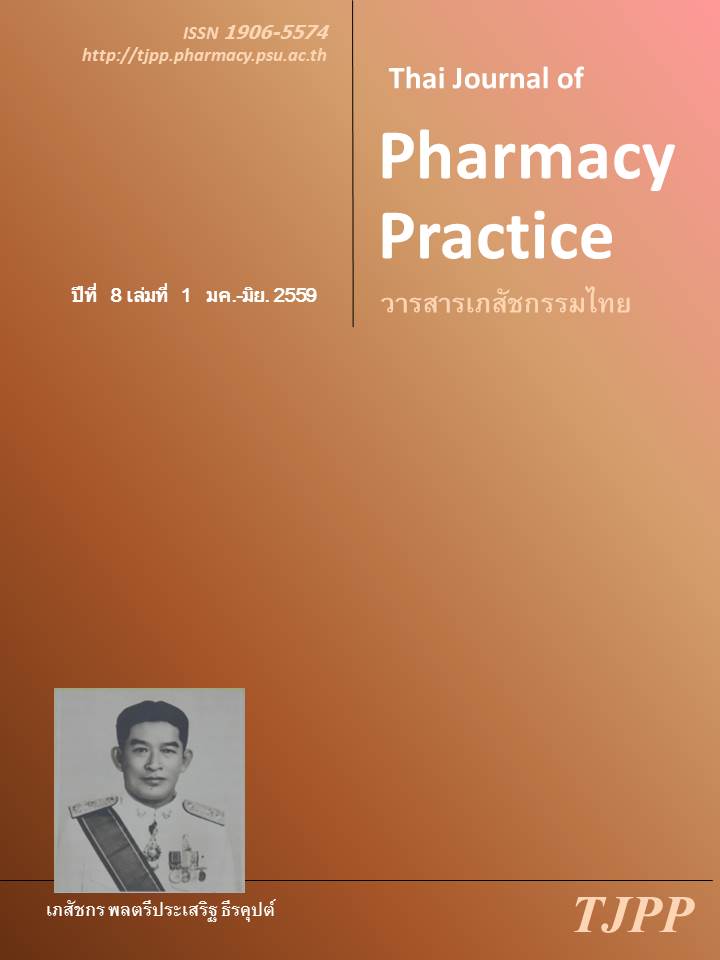ผลจากการมีส่วนร่วมของเภสัชกรในการเยี่ยมบ้านในทีมสหสาขาวิชาชีพ ต่อความดันโลหิตและความร่วมมือการใช้ยาของผู้ป่วยโรคหลอดเลือดสมอง
Main Article Content
บทคัดย่อ
วัตถุประสงค์: เพื่อศึกษาผลจากการมีส่วนร่วมของเภสัชกรในทีมสหสาขาวิชาชีพในการเยี่ยมบ้านต่อความดันโลหิต และความร่วมมือในการใช้ยาลดความดันโลหิตของผู้ป่วยโรคหลอดเลือดสมอง วิธีการ: ตัวอย่าง คือ ผู้ป่วยโรคหลอดเลือดสมองจำนวน 34 ราย ที่ได้รับการเยี่ยมบ้านโดยทีมสหสาขาวิชาชีพ แต่ยังไม่มีเภสัชกรเข้าร่วมทีมเยี่ยมบ้าน รูปแบบการวิจัย คือการศึกษากึ่งทดลองแบบไม่มีกลุ่มควบคุม โดยวัดความดันโลหิตและความร่วมมือในการใช้ยาลดความดันโลหิต ก่อนและหลังการมีเภสัชกรร่วมกับทีมสหสาขาวิชาชีพในการเยี่ยมบ้าน ตัวอย่างแต่ละรายได้รับการเยี่ยมบ้านโดยมีเภสัชกรร่วมทีม เดือนละ 1 ครั้ง ติดต่อกัน 3 เดือน ระหว่างเดือนธันวาคม 2557 ถึง เดือนกุมภาพันธ์ 2558 เภสัชกรอธิบายให้ผู้ป่วยหรือผู้ดูแลทราบถึงข้อบ่งใช้ของยาที่ผู้ป่วยได้รับทุกรายการ อธิบายผลของการควบคุมความดันโลหิตเพื่อลดการเกิดโรคหลอดเลือดสมองซ้ำ อธิบายวิธีการจัดเวลาการบริหารยา ให้คำแนะนำอื่น ๆ ในกรณีที่พบปัญหาจากการใช้ยา และตอบคำถามที่ผู้ป่วยหรือผู้ดูแลสงสัย การเก็บข้อมูลระดับความดันโลหิตใช้เครื่องวัดความดันโลหิตแบบอิเล็กทรอนิกส์ และวัดความร่วมมือในการใช้ยาลดความดันโลหิตโดยวิธีนับเม็ดยา ผลการวิจัย: เมื่อเปรียบเทียบข้อมูลก่อน (วัดในการเยี่ยมบ้านครั้งที่ 1) และหลัง (วัดในการเยี่ยมบ้านครั้งที่ 3) การมีเภสัชกรร่วมกับทีมสหสาขาวิชาชีพในการเยี่ยมบ้าน พบว่า กลุ่มตัวอย่างมีค่าความดันโลหิตขณะหัวใจบีบตัวเฉลี่ยลดลงจาก 147.59±5.67 เป็น 140.26±7.61 มิลลิเมตรปรอท (P<0.01) ค่าความดันโลหิตขณะหัวใจคลายตัวเฉลี่ยลดลงจาก 90.24± 8.81 เป็น 86.03±7.55 มิลลิเมตรปรอท (P=0.01) และความร่วมมือในการใช้ยาลดความดันโลหิตเฉลี่ยเพิ่มขึ้นจากร้อยละ 80.43±17.01 เป็น 89.69±9.67 (P<0.01) สรุป: เภสัชกรร่วมเยี่ยมบ้านผู้ป่วยโรคหลอดเลือดสมองกับทีมสหสาขาวิชาชีพ ส่งผลให้ผู้ป่วยมีระดับความดันโลหิตลดลงและความร่วมมือในการใช้ยาลดความดันโลหิตเพิ่มขึ้นอย่างมีนัยสำคัญ ดังนั้น การมีเภสัชกรร่วมเยี่ยมบ้านผู้ป่วยโรคหลอดเลือดสมองในทีมสหสาขาวิชาชีพจึงควรได้รับการส่งเสริม เพื่อเพิ่มคุณภาพการดูแลผู้ป่วยกลุ่มนี้ให้สูงขึ้น
Article Details
ผลการวิจัยและความคิดเห็นที่ปรากฏในบทความถือเป็นความคิดเห็นและอยู่ในความรับผิดชอบของผู้นิพนธ์ มิใช่ความเห็นหรือความรับผิดชอบของกองบรรณาธิการ หรือคณะเภสัชศาสตร์ มหาวิทยาลัยสงขลานครินทร์ ทั้งนี้ไม่รวมความผิดพลาดอันเกิดจากการพิมพ์ บทความที่ได้รับการเผยแพร่โดยวารสารเภสัชกรรมไทยถือเป็นสิทธิ์ของวารสารฯ
เอกสารอ้างอิง
2. Burden of Disease Thailand. The burden of disease and injury of Thailand's population 2011. Bangkok: Veterans' Organizations Publisher; 2014.
3. Kerman WN, Ovbiagele B, Black HR, Bravata DM, Chimowitz MI, Ezekowitz MD, et al. Guidelines for the prevention of stroke in patients with stroke and transient ischemic attack: A guideline for healthcare professionals from the American Heart Association/American Stroke Association. Stroke 2014; 45: 2160-236.
4) Chambers JA, O’Carroll RE, Hamilton B, Whittaker J, Johnston M, Sudlow C, et al. Adherence to medication in stroke survivors: A qualitative comparison of low and high adherers. Br J Health Psychol 2011; 16: 592–609.
5) Allen KR, Hazelett S, Jarjoura D, Wickstrom GC, Hua K, Weinhardt J, et al. Effectiveness of a postdischarge care management model for stroke and transient ischemic attack: A randomized trial. J Stroke Cerebrovasc Dis 2002; 11: 88-98.
6) The American Society of Health-System Pharmacists. ASHP guidelines on the pharmacist’s role in home care. Am J Health Syst Pharm 2000; 57: 1252-7.
7) Catania PN. What is the role of the pharmacist in home care? Home Care Provid 1997; 2: 229-31.
8) Public Health Nursing Division. Home Health Care. Bangkok: Health Department of Bangkok Metropolitan Administration; 2012.
9) Nisittra P. Effects of discharge counseling and home-based interventions provided by pharmacist among elderly patients [dissertation]. Khon Kaen: Khon Kaen University; 2007.
10) Unwin BK, Jerant AF. The home visit. Am Fam Physician 1999;60:1481-8.
11) Hohmann C, Neumann-Haefelin T, Klotz JM, Freidank A, Radziwill R. Adherence to hospital discharge medication in patients with ischemic stroke: A prospective, interventional 2-phase study. Stroke 2012; 44: 522-4.
12) Souter C, Kinnear A, Kinnear M, Mead G. Optimisation of secondary prevention of stroke: A qualitative study of stroke patients’ beliefs, concerns and difficulties with their medicines. Int J Pharm Pract 2014; 22: 424–32.
13) Lawes CMM, Bennett DA, Feigin VL, Rodgers A. Blood pressure and stroke: An overview of published reviews. Stroke 2004;35: 1024-33.
14) Hanchaiphiboolkul S, Poungvarin N, Nidhinandana S, Suwanwela NC, Puthkhao P, Towanabut S, et al. Prevalence of stroke and stroke risk factors in Thailand: Thai Epidemiologic Stroke (TES) study. J Med Assoc Thai. 2011; 94: 427-36.
15) Sathirapanya C, Sathirapanya P, Trichan J. Prevalence, risk factors of stroke and post stroke depression in Phatthalung Province: A cross sectional study. Songklanagarind Medical Journal 2014; 32: 275-82.


